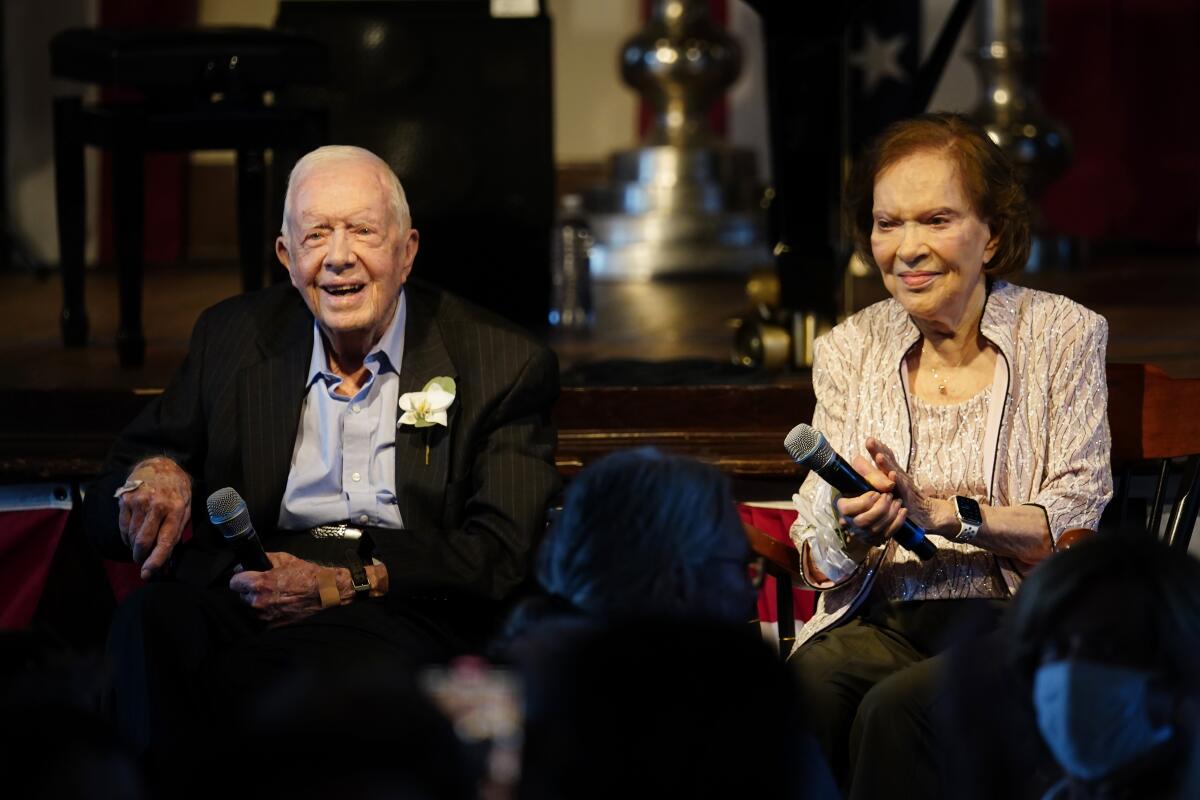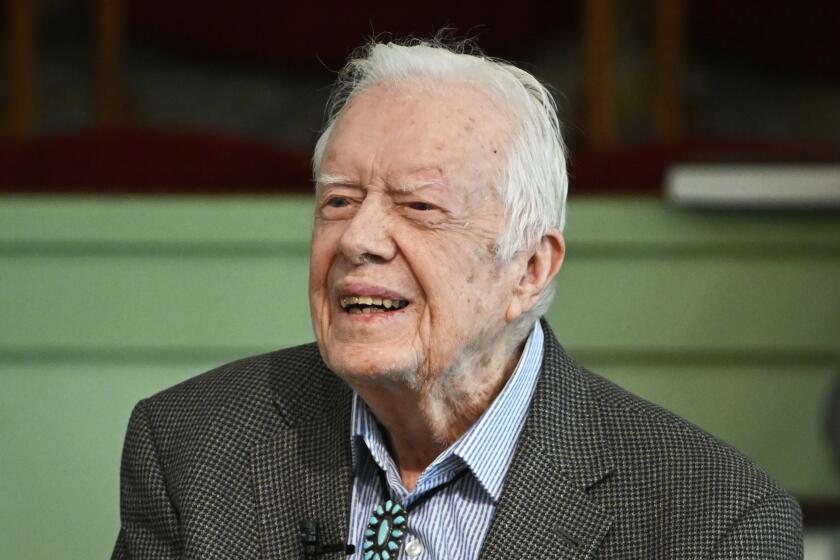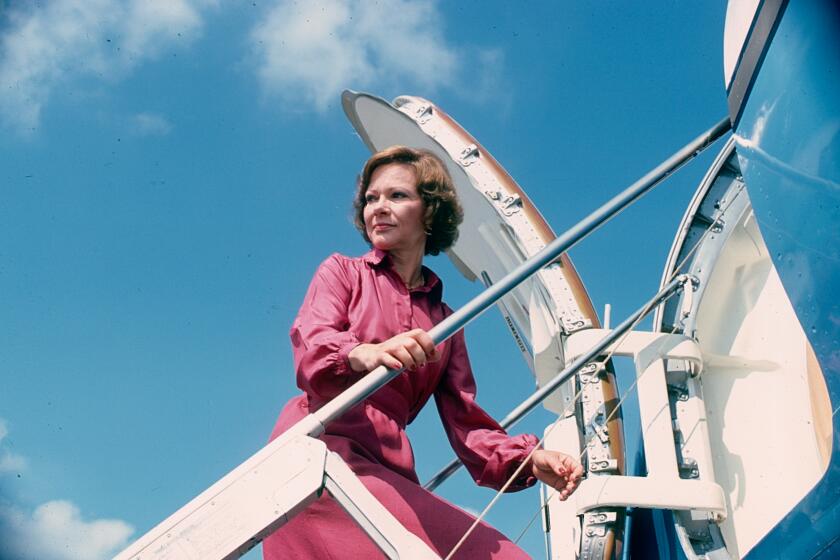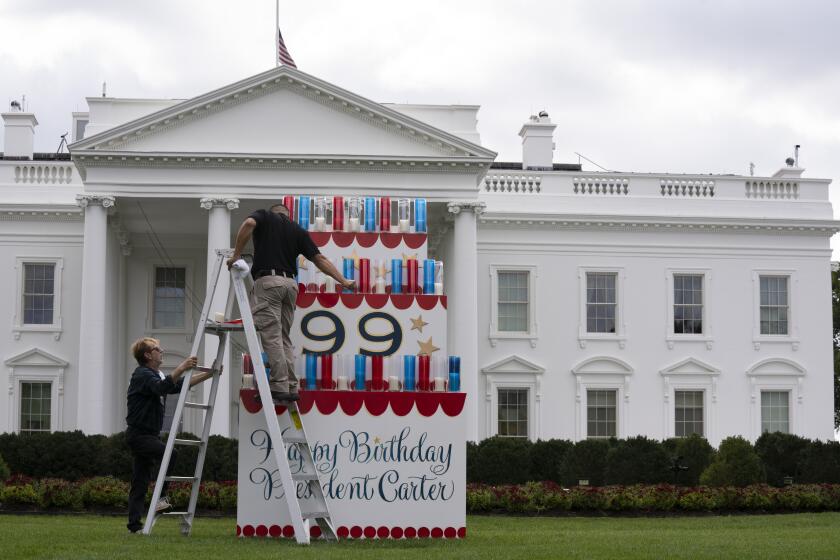A year after Jimmy Carter entered hospice care, advocates hope his endurance drives awareness

- Share via
ATLANTA — Since Jimmy Carter entered hospice care at his home in south Georgia one year ago, the former U.S. president has celebrated his 99th birthday, enjoyed tributes to his legacy and lost his wife of 77 years.
Rosalynn Carter, who died in November, about six months after the Carter family disclosed her dementia diagnosis, lived only a few days under hospice supervision, with her frail husband at her bedside.
Experts on end-of-life care say the Carters’ different paths show the range of an oft-misunderstood service. Those advocates commend the Carter family for demonstrating the realities of aging, dementia and death. They express hope that the attention spurs more Americans to seek out services intended to help patients and families in the latter stages of life.
“It’s been massive to have the Carters be so public,” said Angela Novas, chief medical officer for the Hospice Foundation of America, based in Washington. “It has shed hospice in a new light, and it’s raised questions” for people to learn more.
The Carter family released a statement ahead of Sunday, the one-year anniversary of their announcement that the 39th president would forgo future hospital stays and enter end-of-life care at home in Plains.
The 98-year-old former president has decided to spend his time at home with family instead of receiving “additional medical intervention,” the Carter Center said.
“President Carter continues to be at home with his family,” the statement said. “The family is pleased that his decision last year to enter hospice care has sparked so many family discussions across the country on an important subject.”
The family has not confirmed whether Carter remains in hospice care or has been discharged, as sometimes happens when even a frail patient’s health stabilizes.
Here is a look at hospice and the Carters’ circumstances:
Hospice serves everyone
Mollie Gurian is vice president of Leading Age, a national network of more than 5,000 nonprofit elder-care agencies. She described hospice as “holistic care ... for someone who is trying to live the end of their life as fully as possible” but no longer seeks a cure for a terminal condition.
Hospice offers multiple practitioners for each patient: nurses, physicians and social-service professionals like chaplains and secular grief counselors. Home hospice features in-home visits but not round-the-clock or even full-shift care.
Initial eligibility requires a physician’s certification of a terminal condition, with the expectation that a person will not live longer than six months; there are also disease-specific parameters.
For-profit businesses or nonprofit agencies typically provide the care and employ the providers. Medicare pays those agencies a per-day rate for each patient. There are four levels of care and daily rates. The concept was developed after World War II and has been part of the Medicare program since the early 1980s. Private insurance plans also typically cover hospice.
In 2021, 1.7 million Medicare beneficiaries enrolled in hospice at a taxpayer cost of $23.1 billion, according to the federal Medicare Payment Advisory Commission (MedPAC). Almost half of Medicare patients who died that year did so under hospice care.
More than the ‘morphine myth’
Hospice can elicit images of “someone doped up and bedridden,” but it is not “just providing enough morphine to make it through the end,” Gurian said.
Indeed, patients give up curative treatments and many medicines. Cancer patients no longer receive radiation or chemotherapy. Those with late-stage Alzheimer’s, Parkinson’s or another degenerative neurological disease typically ditch cholesterol and blood-pressure medication — and eventually drugs that regulate their acute condition.
But Novas and Gurian said treatment is case-by-case. Some agencies might allow someone with end-stage kidney disease to get dialysis or take regulatory medication. They simply have to absorb the cost, because Medicare almost certainly does not pay separately for those treatments.
Former First Lady Rosalynn Carter sat in on husband Jimmy Carter’s Cabinet meetings and advocated for mental health legislation. She has died at 96.
Further, hospice does not necessarily mean forgoing treatments for certain complications that threaten comfort: antibiotics for a urinary tract infection or infected bed sores, for example. That said, patients or families may forgo such treatments, especially in cases of end-stage neurological disease.
Chip Carter, one of Jimmy and Rosalynn Carter’s four children, confirmed to the Washington Post that his mother was suffering from a severe urinary tract infection at the time of her hospice admission and death. In those cases, Novas explained, patients are administered pain management drugs.
Jimmy Carter’s endurance is not unusual
In 2021, the average stay of hospice patients who died was 92 days, MedPAC calculated. The median was 17 days — about two weeks longer than the time between when the Carters’ announced the former first lady had entered hospice and when she died.
About 10% of enrollees who die in hospice care stayed more than 264 days. Extended cases drive a majority of costs. In 2021, $13.6 billion of the overall $23 billion paid was for stays exceeding 180 days before death. Of that, $5 billion was for stays longer than a year.
Jimmy Carter put off his usual practice of watching Sunday services online to celebrate his 99th birthday with wife Rosalynn and other family in Plains, Ga.
Patients are sometimes discharged from hospice if their condition stabilizes, especially if they have reached the six-month mark in the program. In 2021, 17.2% of the patients were discharged. The MedPAC report to Congress noted that for-profit agencies have higher average length of stays than nonprofits and added that living patients’ discharge rates raise questions about admission standards.
Novas offered explanations. She said hospice has seen an uptick in patients with dementia, conditions in which “a patient can wax and wane for months or even years.” Another factor — one she said could explain Jimmy Carter’s endurance — is sheer grit.
“We cannot measure the human spirit,” she said. With many conditions, “somebody who wants to be here is going to stick around for a while.”
Advocates want changes and expansion
Medicare does not include a long-term care insurance provision, something that Leading Age and other advocates argue the U.S. needs, especially as the baby boomer generation ages.
That kind of care, she said, would help patients and families absorb significant burdens of care that hospitals do not provide and that hospice does not cover — or at least should not cover. A long-term care benefit, for example, could become a more common route of insured care in some dementia cases.
Legislation has been introduced in Congress in recent sessions to create a long-term care plan under Medicare. But it is politically difficult, if not impossible, because it calls for an increase in payroll taxes to finance a new benefit.
Separately, Gurian said Leading Age would like Congress to increase hospice payments structures so more agencies might admit patients and still cover certain treatments they now typically forgo. For example, she said some cancer patients could ratchet down cancer treatments as part of pain management rather than give up treatment altogether and advance more rapidly to heavy drugs like morphine that eliminate quality of life.
Jimmy Carter still offering lessons
Gurian said the U.S. healthcare system and American society too often see just two choices for someone with a grave diagnosis: “fighting” or “giving up.”
“Hospice is not giving up,” she said, even if it means “accepting our mortality.”
Novas said Jimmy Carter has proven those distinctions with his public announcements and, in November, his determination to attend Rosalynn Carter’s funeral, physically diminished, reclined in a wheelchair, his legs covered in a blanket.
“That was such an important moment,” Novas said, for the world to “see what 99 looks like,” even for a former president. “He still has lessons for us. I think, on some level, he must be aware of what he’s doing. ... Hospice is just a partner in that journey. But it’s his journey.”
More to Read
Sign up for Essential California
The most important California stories and recommendations in your inbox every morning.
You may occasionally receive promotional content from the Los Angeles Times.













